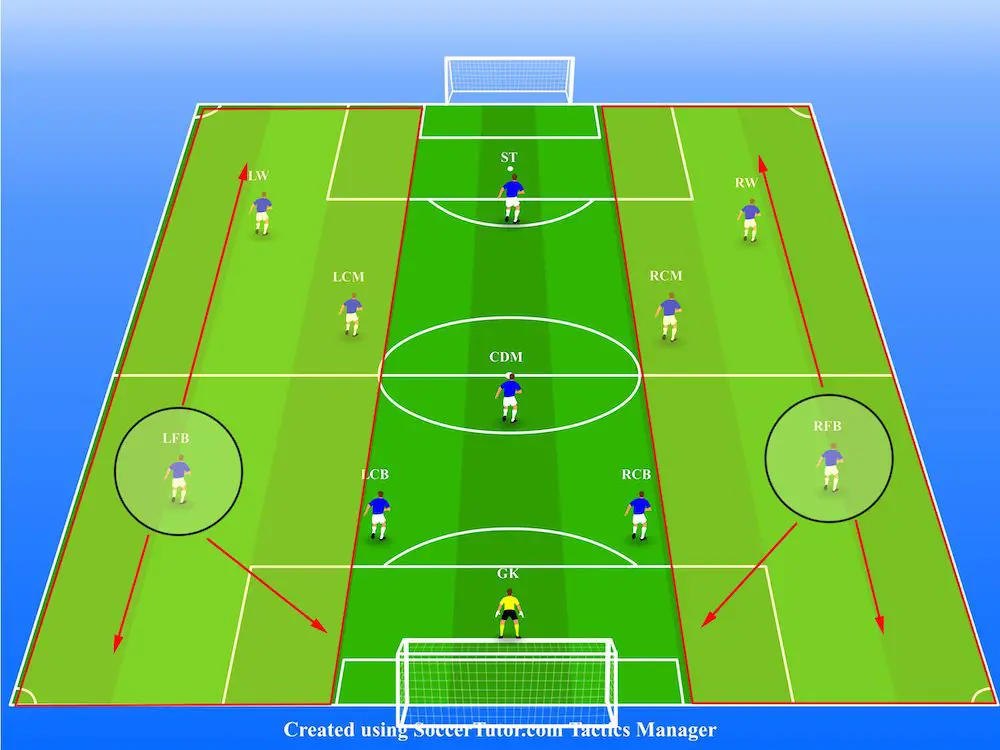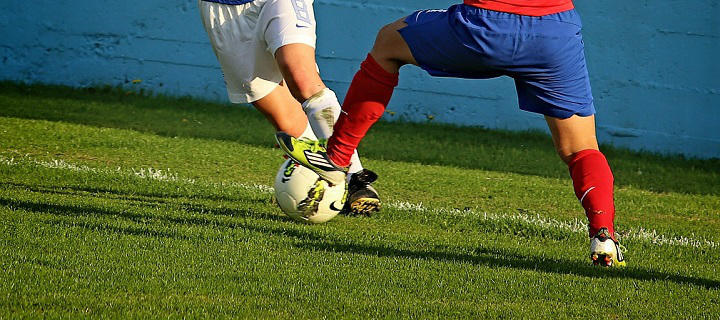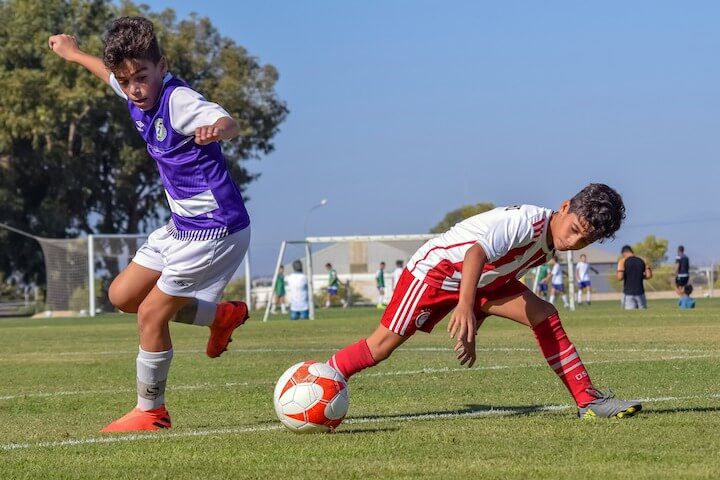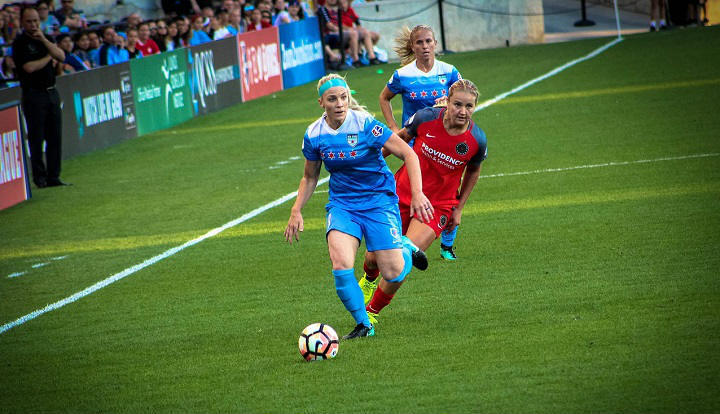What is a Fullback in Soccer? (Full Position Guide)
Teams deploy fullbacks on either end of the backline, operating as wide defenders up and down the entire length of the field.
Once viewed as insignificant players who simply fill in the numbers and perform basic defensive tasks...
The role of a fullback has now evolved enormously.
In fact, fullbacks have arguably grown in importance more than any other position in the past decade.
As well as marking opposition wingers and stopping crosses from wide areas, modern fullbacks must now offer an attacking threat.
Today’s fullbacks are more akin to traditional wingers and require a robust skill set on and off the ball.
Although they’re defenders first, coaches encourage fullbacks to join attacks where possible.
Below we'll dive into the fullback position, breaking down the key roles, responsibilities, and traits to help you elevate your game.
What is a Fullback in Soccer?
A fullback in soccer is a wide defender who plays on either side of a back four.
There are typically two fullbacks on the field at all times: a right back and a left back.
A fullback’s primary role is to defend their quadrant.
This involves marking the opposition winger, winning defensive duels in wide areas, and preventing crosses.
The secondary defensive responsibility of a fullback is to provide cover when the ball is on the opposite side of the field.
When an opponent attacks down a particular side, the entire backline shifts in that direction, shutting down passing options and increasing protection around the goal area.
The opposite fullback tucks in and is responsible for defending the back post and tracking any late runners into the box.
When their team is in possession, modern fullbacks must also offer an attacking threat.
Their attacking arsenal should contain an eye for a pass, pinpoint crossing, and 1v1 dribbling skills.
It’s important for fullbacks to build relationships with their wingers.
Intricate give-and-go passes as well as overlapping and underlapping runs are staples of top-class wing partnerships.
Position of a Fullback
Fullbacks play mainly along the wings, whether they’re attacking or defending.
Their starting position is either in line or slightly ahead of the center backs in the defensive third of the field.
In the defensive phases, the backline moves as a unit to either (1) drop back and absorb pressure, or (2) step up and press the opposition.
Fullbacks need to tuck in and cover the back post when the ball is on the opposite side, preventing any clear gaps from opening centrally.
In possession, the position of a fullback can vary a lot...
Regardless of how advanced they are up the field, when their team is on the ball, fullbacks tend to hit the sidelines and stay as wide as possible.
This positioning strategy stretches the opponent out as much as possible. Creating space to retain possession, make probing passes, and create chances.
In the build-up phases, fullbacks are likely to drop deep to offer a passing outlet.
But if they don’t receive the ball in this phase, they should position themselves further up the sideline to offer a more attacking threat.
When the ball is on their side, fullbacks must be willing to attack, either directly or by making overlapping and underlapping runs.

What Does a Fullback Do in Soccer?
Combining a vast skill set and bringing both offensive and defensive work to the table, a modern fullback wears a lot of hats.
If you want to learn how to dominate as a fullback in soccer, you must first understand the core responsibilities.
In the next section, I break down exactly what a fullback does in attack and defense, giving you a framework to help you improve.
Fullback's Role In Defense
#1 - Defend Wide Areas
Operating as a key cog in the defensive unit, the fullback’s main focus is to defend their quadrant of the field.
Since the final third is the most dangerous area, fullbacks must have this section locked down.
This means being positionally responsible and making safe choices when it comes to defending.
Although attacking fullbacks are extremely valuable in today’s game, venturing out of secure defensive positions brings about a lot of risks.
Right and left backs must learn when to attack and when to sit alongside their backline.
#2 - Win 1v1s
The winger vs fullback duel is always a fun one.
It’s essentially a matchup between the best 1v1 attacker and the best 1v1 defender.
Fullbacks must be able to match their opposing winger’s attacking flair with solid defensive fundamentals.
In general, the most space on a soccer field lies on the wings.
Therefore, wide areas are key for creating chances and establishing solid attacks.
By winning the individual battles on either flank, fullbacks can effectively limit their opponents’ attacking threats.
#3 - Cover Crosses from Both Sides
The wings are some of the most fruitful areas for teams to create chances.
One of the most important duties of either fullback is to stem the supply of crosses.
If a cross makes its way into the penalty box, the fullback on the opposite side must ensure they cover the back post and defend any late runners.
Preventing direct crosses successfully comes down to positioning, discipline, and timing.
The defender should be close enough to the winger to block their path to the box but they must not get so tight, leaving the defensive vulnerable if they get beaten 1v1.
One of the golden rules of defending is to avoid diving in, which essentially means not overcommitting to a challenge.
Fullbacks must have a disciplined approach, waiting for the right time to engage the attacker or stick their leg out to block the cross.
Fullback's Role In Attack
#4 - Contribute to Build-Up Play
Although the extent to which a fullback contributes to build-up play depends on the individual team’s system...
Right and left backs see A LOT of the ball.
They're key passing outlets for several important positions, including the goalkeeper, center backs, center midfielders, and wingers.
In many cases, the fullback can keep things simple, making short passes to recycle possession and keep the ball moving.
However, the best fullbacks use their well-rounded skillset to give a little bit more going forward.
Switching the play with crossfield balls, playing line-breaking passes, or advancing into more dangerous positions will make a fullback more threatening in build-up phases.
#5 - Attack in Tandem with Wingers
Perhaps the most dangerous method of attacking from wide areas is to do so in tandem, with a fullback and winger duo.
Fullbacks and wingers who have a good understanding of each other can put together slick and fluid offensive work.
These duos should know each other’s strengths, weaknesses, and tendencies, ensuring they can complement each other.
Strong partnerships are born from hard work on the training field.
Wingers and fullbacks should practice different sequences, involving overlaps and underlaps, as well as dummy runs and quick give-and-go movements.
#6 - Supply Crosses
In any given season, approximately a quarter of goals scored come from crosses.
Since modern fullbacks are more attack-minded than ever before, they find themselves in great positions to whip in crosses.
This is where having a robust all-around skill set comes in.
To take full advantage of getting into dangerous areas, fullbacks must have the vision and technique to execute.
They should be capable of delivering different types of crosses, from deep lofted balls to low-driven cutbacks.

5 Key Traits of a Fullback
While players of different sizes and skill sets can be effective in all positions, most fullbacks conform to a more definite archetype.
They’re hard-working, fit, and tenacious defenders with the desire and drive to not only win the individual battle, but to offer an attacking threat too.
With this in mind, let’s take a look at the key traits of a dominant fullback in modern soccer.
a. Stamina
With plenty of attacking and defensive responsibilities in each game, fullbacks need to have elite levels of stamina.
In addition to defending tricky wingers, fullbacks must also have adequate fitness levels to bomb forward in attack and sprint backward to make recovery runs.
In soccer, the tide can turn in an instant, especially in the latter moments when fatigue sets in.
Fullbacks must be able to sustain their levels for 90 minutes plus injury time, week in and week out.
Otherwise, they run the risk of making costly errors in the dying minutes of games.
b. Defensive Fundamentals
Facing up against skillful wingers and powerful strikers, there is little margin for error for fullbacks.
They must hone and refine their defensive fundamentals to ready themselves for all defensive scenarios.
The key fundamentals of a fullback include good tackling, heading, blocking, and intercepting.
In addition to these physical skills, great defenders are mentally sharp.
They understand positioning and timing so they can leverage their defensive technique to maximum effectiveness.
c. Great Positioning
With so many attacking and defensive duties, it’s easy for a fullback to get caught out of position occasionally.
Top fullbacks are positionally disciplined and always in the right place at the right time.
While most fullbacks can learn attacking and defending positioning quickly, transitions are much trickier to master.
For the most part, this comes down to awareness, reading of the game, and risk management.
Even when they’re in offensive positions, elite fullbacks must know what’s behind them.
d. Acceleration and Pace
Pace and acceleration are essential in both halves of the field.
Defensively, fullbacks must have the acceleration to match the opposition winger over short distances.
When it comes to a footrace, it’s also critical that they have enough pace to keep up with attackers.
Going forward, pace and acceleration are less important.
However, speed is a deadly weapon for a fullback if they’re facing defenders 1v1 in the final third.
e. Striking Technique
As important creative outlets, high-level fullbacks have excellent striking technique.
This allows them to thread killer passes to their strikers and whip dangerous crosses into the penalty area.
One-dimensional fullbacks who don't have good striking technique are much easier to defend against.
Best Fullbacks of All Time
We’ve seen some phenomenal right and left backs over the years.
Choosing an all time list of fullbacks is a mean feat, but someone has to do it.
So, here’s my pick for the best fullbacks of all time.
- Paolo Maldini
- Cafu
- Roberto Carlos
- Giacinto Facchetti
- Djalma Santos
- Phillip Lahm
- Carlos Alberto
- Dani Alves
- Javier Zanetti
- Lilian Thuram

5 Bonus Tips for Fullback
As a position that continues to evolve with each passing season, up-and-coming fullbacks should work on their game consistently.
To help accelerate your progress, here are some pro tips worth noting.
Tip #1: Practice 1v1s
Every player has a different skill set.
To prepare for all comers, be sure to work on 1v1 defending with as many different player types as possible.
You’ll quickly learn what approaches work best against certain attackers.
For example, with tricky, skillful wingers, closing them down quickly can cut down the available space and limit their effectiveness.
However, with speedy wingers, it’s often beneficial to stand off them slightly to prevent them from knocking the ball past you and running.
Tip #2: Improve Your Conditioning
Fullbacks go through a significant amount of work in each game, spending 90 minutes running up and down the wings.
To ensure you can meet the demands of a full season, be sure to stay in shape.
Elite stamina not only ensures you can keep up for an entire game, but it helps preserve your career in the long term and reduce your risk of injury.
Tip #3: Prioritize Recovery
As one of the most physically demanding positions on the field, fullbacks tend to pick up knocks and niggles.
To stop these minor issues from turning into major injuries, fullbacks should prioritize recovery.
Make sure to stretch before and after training sessions and games.
If you want to take things further, consider ice baths and active recovery on your off days.
Rest and diet can also play a major role.
Tip #4: Work on Technical Skills
Having the energy and tactical knowledge to get into the right positions means nothing if you lack the skills to have a positive impact.
In addition to honing your defensive fundamentals, it’s important to develop a solid first touch, dribbling skills, and a good passing range.
You can learn excellent technical skills on the training field.
Additional sessions in your backyard can accelerate progress even faster.
Tip #5: Study the Greats
The fullback role has been interesting to observe in recent years as the standard of play continues to rise.
It’s no longer acceptable to learn the basics and just show up. You must continually look to improve your skill set and evolve.
One of the best ways to do this is to study the best players in the world.
In the modern era, there is virtually endless footage of all players.
Seek out the top fullbacks from high-level leagues and pay attention to what they do in 1v1 situations, transitions, and attacking phases.

Conclusion
Fullback is an increasingly fun position to play in.
You get the opportunity to do a little bit of everything and you’re likely to see a lot of the ball.
However, it’s by no means easy.
I hope this guide helps you gain a better understanding of the role as well as what’s required to excel in the position.

